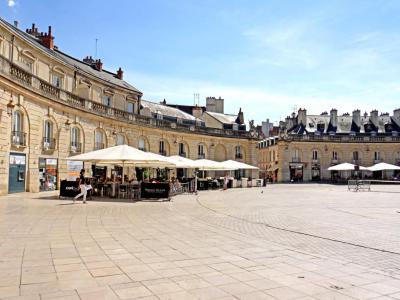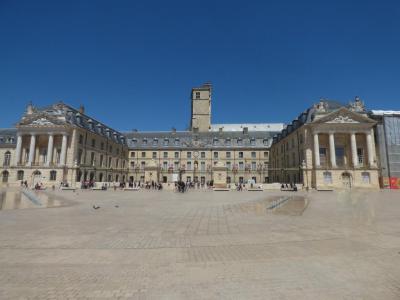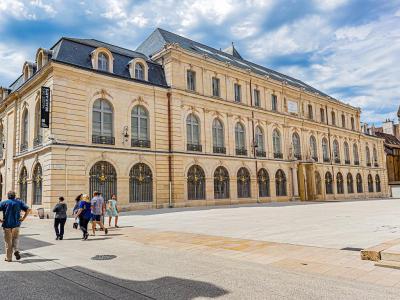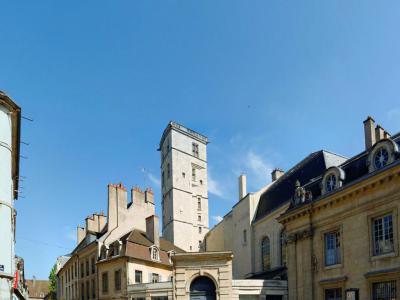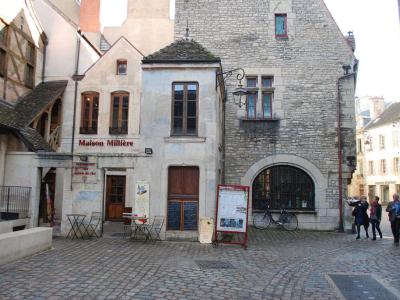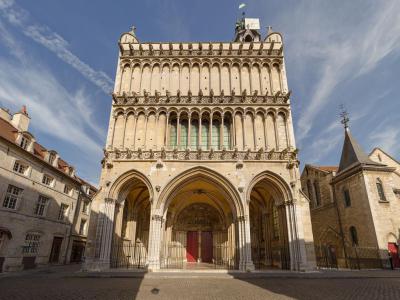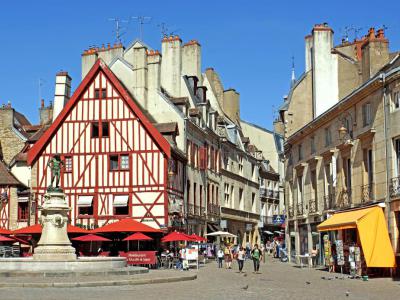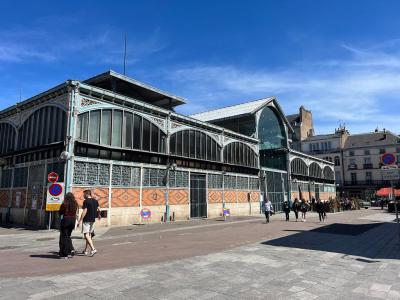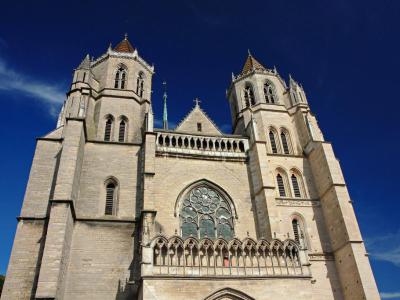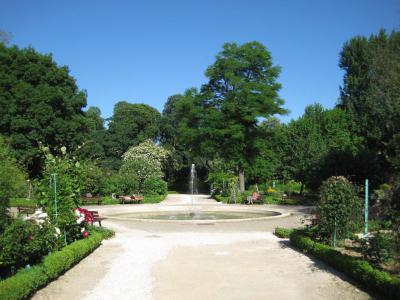
Dijon Introduction Walking Tour (Self Guided), Dijon
Nestled amid the undulating hills of Burgundy, the capital of the Côte-d'Or admistrative department of France, Dijon, exudes an aura of refinement.
The city's history dates back to Roman times when it was known as Divio. The name "Divio" itself may have roots in the Celtic word "divona" which means "sacred fountain." Over time, it has evolved to "Dijon" and remained so to this day.
During the Middle Ages and Renaissance, Dijon served as the capital of the Duchy of Burgundy and was nicknamed the "City of Dukes". It flourished under the rule of the Valois dukes and became a center of art, culture, and commerce. In the 17th and 18th centuries, Dijon experienced a period of decline but saw a resurgence during the 19th century with the development of the railway system.
Today, the downtown area of Dijon boasts a UNESCO World Heritage designation, because of its well-preserved aristocratic residences and other distinguished properties (“hôtels particuliers”).
The resplendent Palace of the Dukes of Burgundy (Palais des Ducs et des États de Bourgogne) stands as a showcase of Gothic and Renaissance opulence that chronicles the triumphs of the Valois dynasty. Inside, the Museum of Fine Arts (Musee des Beaux-Arts) exhibits an impressive collection of art, including works by local masters such as Gustave Moreau and François Rude.
As you meander through the cobbled Forges Street (Rue des Forges), a medieval tableau unfurls. Wander here at leisure, stopping to admire medieval half-timbered houses and Renaissance mansions.
The Church of Our Lady of Dijon (Eglise Notre-Dame de Dijon) is a sublime testament to Burgundian Gothic architecture. The church dates back to the 13th century and is famous for its intricate stonework, impressive rose window, and beautifully sculpted gargoyles.
Strolling along the enchanting paths of Arquebuse Botanical Garden (Jardin de l'Arquebuse), one is transported to a peaceful oasis in the heart of the city. The air in this botanical wonderland is an olfactory kaleidoscope that evokes serenity and contemplation.
The very essence of Dijon is an amalgamation of centuries-old heritage and artistic finesse. If you are a passionate explorer with a taste for tracing the footsteps of history, embark on this self-guided whimsical journey through a labyrinth of timeless tales and unveil some of the secrets of Dijon with every stride.
The city's history dates back to Roman times when it was known as Divio. The name "Divio" itself may have roots in the Celtic word "divona" which means "sacred fountain." Over time, it has evolved to "Dijon" and remained so to this day.
During the Middle Ages and Renaissance, Dijon served as the capital of the Duchy of Burgundy and was nicknamed the "City of Dukes". It flourished under the rule of the Valois dukes and became a center of art, culture, and commerce. In the 17th and 18th centuries, Dijon experienced a period of decline but saw a resurgence during the 19th century with the development of the railway system.
Today, the downtown area of Dijon boasts a UNESCO World Heritage designation, because of its well-preserved aristocratic residences and other distinguished properties (“hôtels particuliers”).
The resplendent Palace of the Dukes of Burgundy (Palais des Ducs et des États de Bourgogne) stands as a showcase of Gothic and Renaissance opulence that chronicles the triumphs of the Valois dynasty. Inside, the Museum of Fine Arts (Musee des Beaux-Arts) exhibits an impressive collection of art, including works by local masters such as Gustave Moreau and François Rude.
As you meander through the cobbled Forges Street (Rue des Forges), a medieval tableau unfurls. Wander here at leisure, stopping to admire medieval half-timbered houses and Renaissance mansions.
The Church of Our Lady of Dijon (Eglise Notre-Dame de Dijon) is a sublime testament to Burgundian Gothic architecture. The church dates back to the 13th century and is famous for its intricate stonework, impressive rose window, and beautifully sculpted gargoyles.
Strolling along the enchanting paths of Arquebuse Botanical Garden (Jardin de l'Arquebuse), one is transported to a peaceful oasis in the heart of the city. The air in this botanical wonderland is an olfactory kaleidoscope that evokes serenity and contemplation.
The very essence of Dijon is an amalgamation of centuries-old heritage and artistic finesse. If you are a passionate explorer with a taste for tracing the footsteps of history, embark on this self-guided whimsical journey through a labyrinth of timeless tales and unveil some of the secrets of Dijon with every stride.
How it works: Download the app "GPSmyCity: Walks in 1K+ Cities" from Apple App Store or Google Play Store to your mobile phone or tablet. The app turns your mobile device into a personal tour guide and its built-in GPS navigation functions guide you from one tour stop to next. The app works offline, so no data plan is needed when traveling abroad.
Dijon Introduction Walking Tour Map






Guide Name: Dijon Introduction Walking Tour
Guide Location: France » Dijon (See other walking tours in Dijon)
Guide Type: Self-guided Walking Tour (Sightseeing)
# of Attractions: 10
Tour Duration: 2 Hour(s)
Travel Distance: 2.3 Km or 1.4 Miles
Author: nataly
Sight(s) Featured in This Guide:
Guide Location: France » Dijon (See other walking tours in Dijon)
Guide Type: Self-guided Walking Tour (Sightseeing)
# of Attractions: 10
Tour Duration: 2 Hour(s)
Travel Distance: 2.3 Km or 1.4 Miles
Author: nataly
Sight(s) Featured in This Guide:
- Place de la Liberation (Liberation Square)
- Palace of the Dukes of Burgundy
- Musee des Beaux-Arts de Dijon (Museum of Fine Arts)
- Tour Philippe le Bon (Philip the Good Tower)
- Maison Milliere
- Eglise Notre-Dame de Dijon (Church of Notre-Dame of Dijon)
- Rue des Forges (Forges Street)
- Halles de Dijon (Dijon Indoor Market)
- Cathedrale Saint-Benigne de Dijon (Dijon Cathedral)
- Jardin de l'Arquebuse (Arquebuse Botanical Garden)
1) Place de la Liberation (Liberation Square) (must see)
Liberation Square holds a significant place in the historic center of Dijon. The square's unique design forms a semicircle and is anchored by the Grand Palace of the Dukes of Burgundy. Over the centuries, this square has witnessed various names and undergone several transformations, reflecting the diverse events that shaped its history.
Originally completed in 1686, it was initially named the Royal Square, reflecting its connection to the monarchy. However, during the French Revolution, the statue of Louis XIV, which once stood at its center, was destroyed, and the square was renamed Place d'Armes. With the rise of the French Empire in 1804, it acquired the name Imperial Square. As political tides shifted, the square was named Royal Place during the Restoration period in 1814 and reverted to Place d'Armes in 1831 during the Monarchy of July.
The square experienced further tumultuous times during World War II when Dijon was under German occupation. It was renamed Marshal Pétain Square, named after the controversial French leader. However, after the liberation of Dijon in 1944, the square was given its current name, Place de la Liberation, to commemorate the city's freedom from occupation.
In 2005-2006, Liberation Square underwent a significant facelift, enhancing its aesthetic appeal and functionality. Three fountains were installed, becoming prominent features of the square, and the surface was adorned with local Comblanchien limestone, renowned for its beautiful beige color. The renovation also resulted in the restriction of vehicle access, transforming the square into a pedestrian-friendly area. These changes made Liberation Square a popular gathering spot and the heart of public life in Dijon.
Today, Liberation Square serves as a vibrant hub where both locals and tourists converge. Its picturesque setting, combined with the presence of open-air cafes, attracts visitors who come to enjoy a meal or a cup of coffee while observing the bustling atmosphere.
Originally completed in 1686, it was initially named the Royal Square, reflecting its connection to the monarchy. However, during the French Revolution, the statue of Louis XIV, which once stood at its center, was destroyed, and the square was renamed Place d'Armes. With the rise of the French Empire in 1804, it acquired the name Imperial Square. As political tides shifted, the square was named Royal Place during the Restoration period in 1814 and reverted to Place d'Armes in 1831 during the Monarchy of July.
The square experienced further tumultuous times during World War II when Dijon was under German occupation. It was renamed Marshal Pétain Square, named after the controversial French leader. However, after the liberation of Dijon in 1944, the square was given its current name, Place de la Liberation, to commemorate the city's freedom from occupation.
In 2005-2006, Liberation Square underwent a significant facelift, enhancing its aesthetic appeal and functionality. Three fountains were installed, becoming prominent features of the square, and the surface was adorned with local Comblanchien limestone, renowned for its beautiful beige color. The renovation also resulted in the restriction of vehicle access, transforming the square into a pedestrian-friendly area. These changes made Liberation Square a popular gathering spot and the heart of public life in Dijon.
Today, Liberation Square serves as a vibrant hub where both locals and tourists converge. Its picturesque setting, combined with the presence of open-air cafes, attracts visitors who come to enjoy a meal or a cup of coffee while observing the bustling atmosphere.
2) Palace of the Dukes of Burgundy
The Palace of the Dukes and Estates of Burgundy in Dijon is a historically significant architectural complex that showcases a blend of Gothic, classical, and 19th-century styles. Its origins can be traced back to the 14th and 15th centuries when the Gothic ducal palace served as the residence and seat of power for the Dukes of Burgundy.
The oldest section of the palace is a logis that dates back to the 14th and 15th centuries. It provides a glimpse into the architectural style of that era. Additionally, the ducal kitchens on Cour de Bar, the Tour de Philippe le Bon, and the Tour de Bar are remnants of this medieval period.
However, the majority of the palace, as it stands today, was constructed in the 17th and 18th centuries during the classical architectural period. This transformation took place when the palace became a royal residence and housed the Estates of Burgundy. The classical style is evident in the design and layout of the building, reflecting the artistic trends of the time.
The history of the Duchy of Burgundy, from which the palace derives its name, dates back even further. It was established in the 9th century, around the year 880, when the Carolingian kings of France, Louis III and Carloman II, reorganized the Kingdom of Burgundy into duchies and counties. Richard, Count of Autun, also known as "Richard the Justiciar," became the first Margrave and Duke of Burgundy. He held a significant position within the French Peerage and was appointed by King Louis III.
The oldest section of the palace is a logis that dates back to the 14th and 15th centuries. It provides a glimpse into the architectural style of that era. Additionally, the ducal kitchens on Cour de Bar, the Tour de Philippe le Bon, and the Tour de Bar are remnants of this medieval period.
However, the majority of the palace, as it stands today, was constructed in the 17th and 18th centuries during the classical architectural period. This transformation took place when the palace became a royal residence and housed the Estates of Burgundy. The classical style is evident in the design and layout of the building, reflecting the artistic trends of the time.
The history of the Duchy of Burgundy, from which the palace derives its name, dates back even further. It was established in the 9th century, around the year 880, when the Carolingian kings of France, Louis III and Carloman II, reorganized the Kingdom of Burgundy into duchies and counties. Richard, Count of Autun, also known as "Richard the Justiciar," became the first Margrave and Duke of Burgundy. He held a significant position within the French Peerage and was appointed by King Louis III.
3) Musee des Beaux-Arts de Dijon (Museum of Fine Arts) (must see)
The Museum of Fine Arts is a prestigious institution that holds a prominent place among France's oldest and most important museums. Established in 1787, it is situated in the heart of the historic city center of Dijon, within the former ducal palace that once served as the seat of the Burgundy State during the 15th century. Over time, the palace transitioned into the residence of the King and later became the Palace of the Dukes of Burgundy following a remarkable project led by Jules Hardouin-Mansart in the 17th century. The museum boasts 50 different rooms, housing a stunning collection of 1,500 works of art.
The Musée des Beaux-Arts de Dijon houses an extensive and diverse collection that spans various periods and styles of art. Notable highlights include remnants from the opulent court of the Dukes of Burgundy, such as the renowned tombs of Philip the Bold, John the Fearless, and Margaret of Bavaria, adorned with their mourners from the Chartreuse of Champmol. The museum also features a collection of Egyptian antiquities, which includes a rare series of Fayum mummy portraits.
One of the museum's unique offerings is its collection of Roman art, sourced from Switzerland and Germany, making it the sole collection of its kind in France. The Renaissance, 17th, and 18th centuries are well-represented with famous works by esteemed artists like Melchior Broederlam, Verrocchio, Robert Campin (known as the Master of Flémalle), Ambrogio Lorenzetti, Lorenzo Lotto, Titian, Jacopo Pontormo, Paolo Veronese, Jan Brueghel the Elder, Guido Reni, Georges de La Tour, Rubens, Philippe de Champaigne, Charles Le Brun, Jean-Baptiste Greuze, and Hubert Robert.
The Musée des Beaux-Arts de Dijon houses an extensive and diverse collection that spans various periods and styles of art. Notable highlights include remnants from the opulent court of the Dukes of Burgundy, such as the renowned tombs of Philip the Bold, John the Fearless, and Margaret of Bavaria, adorned with their mourners from the Chartreuse of Champmol. The museum also features a collection of Egyptian antiquities, which includes a rare series of Fayum mummy portraits.
One of the museum's unique offerings is its collection of Roman art, sourced from Switzerland and Germany, making it the sole collection of its kind in France. The Renaissance, 17th, and 18th centuries are well-represented with famous works by esteemed artists like Melchior Broederlam, Verrocchio, Robert Campin (known as the Master of Flémalle), Ambrogio Lorenzetti, Lorenzo Lotto, Titian, Jacopo Pontormo, Paolo Veronese, Jan Brueghel the Elder, Guido Reni, Georges de La Tour, Rubens, Philippe de Champaigne, Charles Le Brun, Jean-Baptiste Greuze, and Hubert Robert.
4) Tour Philippe le Bon (Philip the Good Tower) (must see)
The Philip the Good Tower stands tall and proud, offering a breathtaking view of the picturesque town of Dijon and its surrounding landscape. Rising to a height of 46 meters, approximately 150 feet, this magnificent tower holds a significant place in the history and architectural heritage of the region.
Constructed between 1450 and 1460, the Philip the Good Tower was commissioned by Philip the Good, one of the notable Valois Dukes who reigned during the medieval period. It was designed and built in conjunction with the Ducal residence, thereby serving as a testament to Dijon's prestigious past under the rule of the illustrious Valois Dukes.
The tower's architectural plans were masterfully crafted by Jean Poncelet, an accomplished architect hailing from Lyon. Poncelet's expertise and vision ensured that the Philip the Good Tower not only harmonized with the grandeur of the palace but also stood as a symbol of power and authority.
As visitors ascend to the tower's summit, they are greeted with an awe-inspiring panorama that stretches across the charming town of Dijon. The breathtaking view encompasses the town's charming streets, historic landmarks, and the picturesque countryside that envelops the region. The tower's strategic location allows visitors to immerse themselves in the beauty and splendor of the town and gain a deeper appreciation for its rich history and cultural significance.
Constructed between 1450 and 1460, the Philip the Good Tower was commissioned by Philip the Good, one of the notable Valois Dukes who reigned during the medieval period. It was designed and built in conjunction with the Ducal residence, thereby serving as a testament to Dijon's prestigious past under the rule of the illustrious Valois Dukes.
The tower's architectural plans were masterfully crafted by Jean Poncelet, an accomplished architect hailing from Lyon. Poncelet's expertise and vision ensured that the Philip the Good Tower not only harmonized with the grandeur of the palace but also stood as a symbol of power and authority.
As visitors ascend to the tower's summit, they are greeted with an awe-inspiring panorama that stretches across the charming town of Dijon. The breathtaking view encompasses the town's charming streets, historic landmarks, and the picturesque countryside that envelops the region. The tower's strategic location allows visitors to immerse themselves in the beauty and splendor of the town and gain a deeper appreciation for its rich history and cultural significance.
5) Maison Milliere
Maison Millière, a historic establishment dating back five centuries, stands as a splendid representation of medieval architecture. This remarkable structure captivates visitors with its unique features, such as the basket-handle-shaped arcade, the Saint André cross half-timberings, and the intricate sculpted decorations. The Maison Millière exudes a warm and authentic ambiance, offering an ideal setting for gatherings among friends.
One of the main draws of Maison Millière is its culinary offerings. The menu showcases a range of dishes that cater to different tastes and preferences, ensuring there's something for everyone.
To complement the delectable cuisine, Maison Millière offers an impressive selection of Burgundian wines. Known for their rich flavors and regional heritage, these wines perfectly complement the menu offerings, adding an extra touch of sophistication to the dining experience.
For those who prefer non-alcoholic options, Maison Millière also takes pride in offering an extensive array of teas from various corners of the world.The establishment aims to create a truly inclusive and diverse experience for its patrons, ensuring that everyone finds a beverage to their liking.
Beyond its culinary delights, Maison Millière is also a destination for local products, arts, crafts, jewelry, and gifts. Visitors can explore and purchase unique items that celebrate the region's heritage and craftsmanship. From locally sourced ingredients to handcrafted souvenirs, Maison Millière offers an opportunity to bring a piece of the medieval charm home.
One of the main draws of Maison Millière is its culinary offerings. The menu showcases a range of dishes that cater to different tastes and preferences, ensuring there's something for everyone.
To complement the delectable cuisine, Maison Millière offers an impressive selection of Burgundian wines. Known for their rich flavors and regional heritage, these wines perfectly complement the menu offerings, adding an extra touch of sophistication to the dining experience.
For those who prefer non-alcoholic options, Maison Millière also takes pride in offering an extensive array of teas from various corners of the world.The establishment aims to create a truly inclusive and diverse experience for its patrons, ensuring that everyone finds a beverage to their liking.
Beyond its culinary delights, Maison Millière is also a destination for local products, arts, crafts, jewelry, and gifts. Visitors can explore and purchase unique items that celebrate the region's heritage and craftsmanship. From locally sourced ingredients to handcrafted souvenirs, Maison Millière offers an opportunity to bring a piece of the medieval charm home.
6) Eglise Notre-Dame de Dijon (Church of Notre-Dame of Dijon) (must see)
The Church of Notre-Dame of Dijon is a remarkable example of 13th-century Gothic architecture and holds significant historical and cultural importance. Construction on the church began around 1230, and it has since become a cherished symbol of Dijon. The church is home to the statue of Notre-Dame de Bon-Espoir, which was formerly known as the Black Madonna.
One of the notable features of the Church of Notre-Dame of Dijon is its captivating decorations, which include two symbols closely associated with the city itself. The first is the jacquemart, a bell-striking automaton that adds a touch of charm to the church's exterior. The second symbol is the owl, an emblematic creature often associated with Dijon.
Recognized for its architectural and historical significance, the Church of Notre-Dame of Dijon was classified as a Monument Historique in the List of historic monuments in 1840.
Additionally, specific sections of the church, namely the chapel of the Assumption, the sacristy, and the connecting gallery, have been listed as Monuments Historiques since July 5, 2002, further highlighting their architectural and artistic value.
The church's floor plan follows a Latin cross design. The central space is flanked by columns and comprises three levels. The first level consists of six lofty arcades supported by cylindrical columns. Above that is the triforium, covered by slabs which double as the floor for the third level—a gallery with tall windows that allow ample natural light to grace the interior.
The transept, a distinct feature of the church's architecture, is prominently emphasized. It showcases five lancet windows above a solid base, culminating in a captivating rose window. At the crossing of the transept stands a lantern tower, featuring a triforium adorned with eight windows. The church also includes two apsidioles, positioned at each corner between the arms of the transept and the choir.
One of the notable features of the Church of Notre-Dame of Dijon is its captivating decorations, which include two symbols closely associated with the city itself. The first is the jacquemart, a bell-striking automaton that adds a touch of charm to the church's exterior. The second symbol is the owl, an emblematic creature often associated with Dijon.
Recognized for its architectural and historical significance, the Church of Notre-Dame of Dijon was classified as a Monument Historique in the List of historic monuments in 1840.
Additionally, specific sections of the church, namely the chapel of the Assumption, the sacristy, and the connecting gallery, have been listed as Monuments Historiques since July 5, 2002, further highlighting their architectural and artistic value.
The church's floor plan follows a Latin cross design. The central space is flanked by columns and comprises three levels. The first level consists of six lofty arcades supported by cylindrical columns. Above that is the triforium, covered by slabs which double as the floor for the third level—a gallery with tall windows that allow ample natural light to grace the interior.
The transept, a distinct feature of the church's architecture, is prominently emphasized. It showcases five lancet windows above a solid base, culminating in a captivating rose window. At the crossing of the transept stands a lantern tower, featuring a triforium adorned with eight windows. The church also includes two apsidioles, positioned at each corner between the arms of the transept and the choir.
7) Rue des Forges (Forges Street)
Forges Street is a captivating street that holds a significant place in the heart of Dijon. Nestled in the historical center of Dijon, this picturesque street exudes a timeless charm and serves as a gateway to the city's rich heritage. With its historic hôtels particuliers and proximity to notable landmarks, Forges Street is a must-visit destination for both first-time visitors and independent explorers.
As you stroll along Forges Street, you'll be transported back in time, surrounded by the architectural marvels of the past. The street is adorned with several hôtels particuliers, grand manor homes that once belonged to the affluent families of Dijon. These buildings, such as the Hôtel Chambellan, Maison Maillard, and Hôtel Aubriot, showcase a remarkable fusion of architectural styles, reflecting the diverse influences and evolving tastes throughout the centuries.
While Forges Street holds a deep sense of history, it is also a vibrant and bustling thoroughfare that caters to modern-day visitors. The street is lined with an array of charming boutiques, enticing restaurants, delightful dessert parlors, cozy cafes, and other captivating attractions. Whether you're seeking to indulge in the local cuisine, shop for unique souvenirs, or simply soak up the lively ambiance, Forges Street offers a plethora of options to suit every taste.
What makes Forges Street even more appealing is its strategic location, connecting several of Dijon's major attractions. As you traverse the street, you'll encounter the majestic Palace of the Dukes and Burgundy States, an impressive testament to the city's historical significance. This magnificent palace, with its intricate architecture and rich heritage, offers a captivating glimpse into the grandeur of the past.
As you stroll along Forges Street, you'll be transported back in time, surrounded by the architectural marvels of the past. The street is adorned with several hôtels particuliers, grand manor homes that once belonged to the affluent families of Dijon. These buildings, such as the Hôtel Chambellan, Maison Maillard, and Hôtel Aubriot, showcase a remarkable fusion of architectural styles, reflecting the diverse influences and evolving tastes throughout the centuries.
While Forges Street holds a deep sense of history, it is also a vibrant and bustling thoroughfare that caters to modern-day visitors. The street is lined with an array of charming boutiques, enticing restaurants, delightful dessert parlors, cozy cafes, and other captivating attractions. Whether you're seeking to indulge in the local cuisine, shop for unique souvenirs, or simply soak up the lively ambiance, Forges Street offers a plethora of options to suit every taste.
What makes Forges Street even more appealing is its strategic location, connecting several of Dijon's major attractions. As you traverse the street, you'll encounter the majestic Palace of the Dukes and Burgundy States, an impressive testament to the city's historical significance. This magnificent palace, with its intricate architecture and rich heritage, offers a captivating glimpse into the grandeur of the past.
8) Halles de Dijon (Dijon Indoor Market)
Dijon Indoor Market is a hard to miss destination when exploring this charming city. The market is located in a magnificent old cast iron building that dates back to the late 1800s, evoking a sense of history and character. Designed in the style of the famous Halles of Paris, this iconic structure serves as the vibrant heart of a bustling area filled with shops and restaurants.
The market truly comes alive on Tuesdays, Fridays, and Saturdays when the full market takes place. During these days, the area surrounding the Halles building is transformed into a lively scene as vendors set up their stalls, offering a wide array of products such as fresh produce, clothing, souvenirs, and more. It's a feast for the senses as the air fills with enticing aromas and the vibrant colors of the market's offerings captivate your eyes.
On Thursdays, the focus shifts indoors as only the markets within the Halles building are open. Here, visitors can explore a delightful assortment of meats, cheeses, and produce, all of which are integral ingredients in the traditional dishes of Burgundy. It's a chance to discover the regional flavors and ingredients that make Burgundian cuisine so renowned.
If you're not in the mood for cooking or wish to savor the market's offerings immediately, fear not. The market is surrounded by a variety of restaurants where you can indulge in a delightful lunch or dinner. For a quick refreshment, you can even visit the small buvette located within the Halles itself, where you can enjoy a glass of wine and soak in the vibrant atmosphere.
The market truly comes alive on Tuesdays, Fridays, and Saturdays when the full market takes place. During these days, the area surrounding the Halles building is transformed into a lively scene as vendors set up their stalls, offering a wide array of products such as fresh produce, clothing, souvenirs, and more. It's a feast for the senses as the air fills with enticing aromas and the vibrant colors of the market's offerings captivate your eyes.
On Thursdays, the focus shifts indoors as only the markets within the Halles building are open. Here, visitors can explore a delightful assortment of meats, cheeses, and produce, all of which are integral ingredients in the traditional dishes of Burgundy. It's a chance to discover the regional flavors and ingredients that make Burgundian cuisine so renowned.
If you're not in the mood for cooking or wish to savor the market's offerings immediately, fear not. The market is surrounded by a variety of restaurants where you can indulge in a delightful lunch or dinner. For a quick refreshment, you can even visit the small buvette located within the Halles itself, where you can enjoy a glass of wine and soak in the vibrant atmosphere.
9) Cathedrale Saint-Benigne de Dijon (Dijon Cathedral)
Dijon's Cathedral is a remarkable example of Gothic architecture, dating back to the 13th century. Originally functioning as an abbey church, it acquired the status of a cathedral in 1792, taking over the role from the Church of Saint Etienne de Dijon, which had previously served as the seat of the bishopric of Dijon since its establishment in 1731. The cathedral's historical significance is enhanced by its connection to the ancient crypt, which is believed to be the oldest part of the structure and is believed to have been the starting point of the cathedral's construction, as it housed the tomb of Saint Bénigne. Unfortunately, the rotunda that once adorned the church in the 11th century was largely destroyed in 1792, with only the lower floor, which comprises the crypt, surviving to this day.
The Gothic architecture of Dijon Cathedral is a sight to behold. The intricate detailing, soaring arches, and towering spires epitomize the grandeur and elegance of this medieval style. The cathedral's construction represents a testament to the skilled craftsmanship and dedication of the artisans who brought it to life. The tall and slender columns, ribbed vaults, and large stained glass windows create a sense of verticality and lightness within the interior space.
The ancient crypt holds a special place in the cathedral's history. Founded in the 6th century, it predates the main structure and serves as a connection to the early origins of the site. Within the crypt, visitors can explore the tomb of Saint Bénigne, which has been a place of pilgrimage for centuries. The crypt's lower floor, which formed part of the rotunda, is the only remaining portion of the architectural feature that once adorned the cathedral. Its preservation offers a glimpse into the cathedral's past and the architectural elements that once embellished the site.
The Gothic architecture of Dijon Cathedral is a sight to behold. The intricate detailing, soaring arches, and towering spires epitomize the grandeur and elegance of this medieval style. The cathedral's construction represents a testament to the skilled craftsmanship and dedication of the artisans who brought it to life. The tall and slender columns, ribbed vaults, and large stained glass windows create a sense of verticality and lightness within the interior space.
The ancient crypt holds a special place in the cathedral's history. Founded in the 6th century, it predates the main structure and serves as a connection to the early origins of the site. Within the crypt, visitors can explore the tomb of Saint Bénigne, which has been a place of pilgrimage for centuries. The crypt's lower floor, which formed part of the rotunda, is the only remaining portion of the architectural feature that once adorned the cathedral. Its preservation offers a glimpse into the cathedral's past and the architectural elements that once embellished the site.
10) Jardin de l'Arquebuse (Arquebuse Botanical Garden)
The Arquebuse Botanical Garden is a beautiful botanical garden and arboretum spread over 2 hectares of land. It is nestled within a larger park and garden spanning 5 hectares. The history of this remarkable garden dates back to the 16th century when it served as the training grounds for the arquebus knights.
In the late 18th century, the former captain of the chevaliers transformed the site into an English garden, following the designs of renowned landscaper Jean-Marie Morel. The English garden eventually became the property of the city in 1803. Later, in 1833, the plants from Dijon's first botanical garden, originally established in 1771 by writer Bénigne Legouz de Gerland, were transferred to this location, giving birth to the present-day Jardin botanique de l'Arquebuse. In recognition of its significance, the garden was named a Conservatoire Botanique Régional in 2002.
One of the highlights of the Arquebuse Botanical Garden is its impressive collection of nearly 4,000 plant species. The garden focuses on showcasing the rich flora of Bourgogne, the region in which it is situated. Additionally, the garden boasts 1,140 species from around the world, with displays of ornamental plants, food plants, succulents, carnivorous plants, subtropical plants, and Mediterranean plants.
In addition to the extensive plant collections, the Arquebuse Botanical Garden features an arboretum, offering a unique opportunity to study and appreciate different tree species. The garden also houses a herbarium with approximately 100,000 specimens, preserving a vast botanical legacy.
A notable aspect of the Arquebuse Botanical Garden is its collection of Anatidae, which includes various species of wild ducks, geese, and swans.
Entrance to the Jardin botanique de l'Arquebuse is open to the public every day, and there is no charge for admission.
In the late 18th century, the former captain of the chevaliers transformed the site into an English garden, following the designs of renowned landscaper Jean-Marie Morel. The English garden eventually became the property of the city in 1803. Later, in 1833, the plants from Dijon's first botanical garden, originally established in 1771 by writer Bénigne Legouz de Gerland, were transferred to this location, giving birth to the present-day Jardin botanique de l'Arquebuse. In recognition of its significance, the garden was named a Conservatoire Botanique Régional in 2002.
One of the highlights of the Arquebuse Botanical Garden is its impressive collection of nearly 4,000 plant species. The garden focuses on showcasing the rich flora of Bourgogne, the region in which it is situated. Additionally, the garden boasts 1,140 species from around the world, with displays of ornamental plants, food plants, succulents, carnivorous plants, subtropical plants, and Mediterranean plants.
In addition to the extensive plant collections, the Arquebuse Botanical Garden features an arboretum, offering a unique opportunity to study and appreciate different tree species. The garden also houses a herbarium with approximately 100,000 specimens, preserving a vast botanical legacy.
A notable aspect of the Arquebuse Botanical Garden is its collection of Anatidae, which includes various species of wild ducks, geese, and swans.
Entrance to the Jardin botanique de l'Arquebuse is open to the public every day, and there is no charge for admission.
Walking Tours in Dijon, France
Create Your Own Walk in Dijon
Creating your own self-guided walk in Dijon is easy and fun. Choose the city attractions that you want to see and a walk route map will be created just for you. You can even set your hotel as the start point of the walk.
Food and Wine Tour
Speaking of Burgundy, the first thing that springs to mind is wine. Indeed, Burgundy is one of the most prestigious wine regions in France, and its capital Dijon serves as a gateway to this renowned wine country. Dijon also boasts one of the most distinguished gastronomic pedigrees of any place in the world.
Start your gastronomic journey of the city at the Municipal Library (Bibliothèque... view more
Tour Duration: 1 Hour(s)
Travel Distance: 1.9 Km or 1.2 Miles
Start your gastronomic journey of the city at the Municipal Library (Bibliothèque... view more
Tour Duration: 1 Hour(s)
Travel Distance: 1.9 Km or 1.2 Miles
The Most Popular Cities
/ view all
